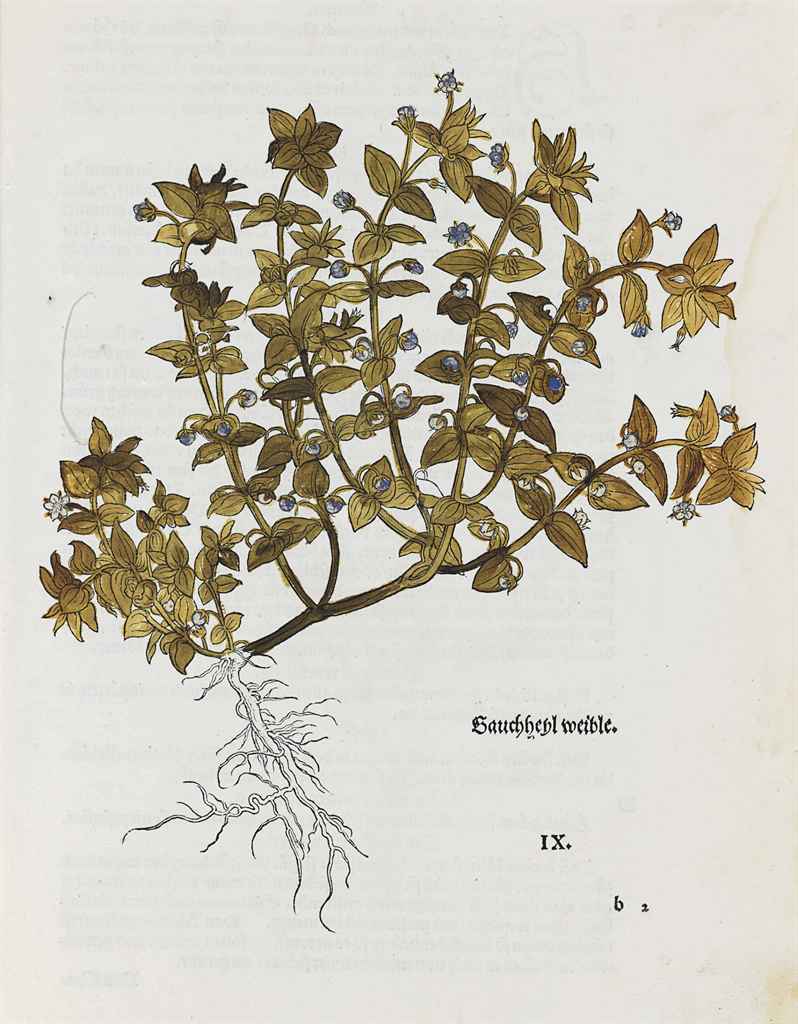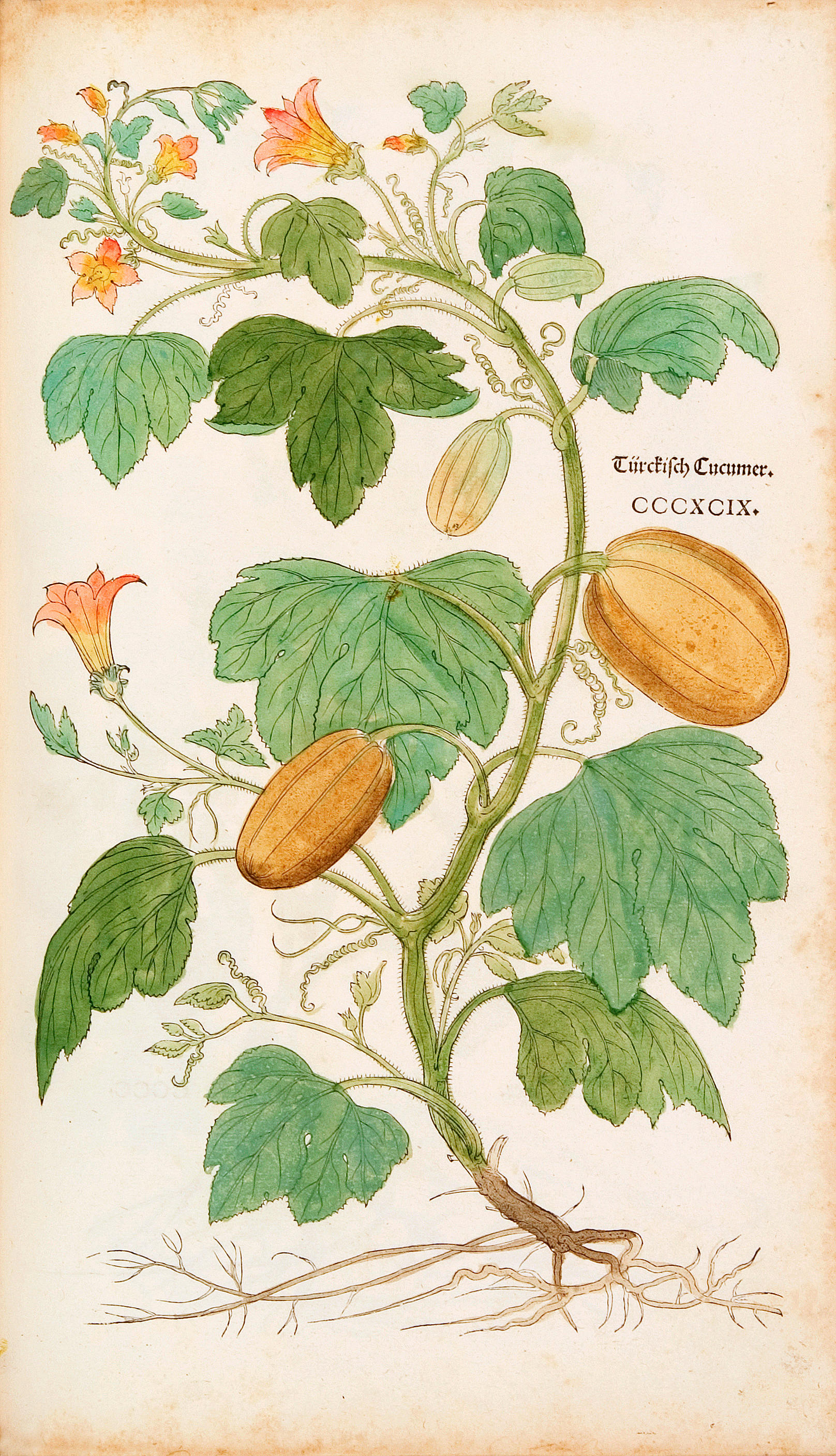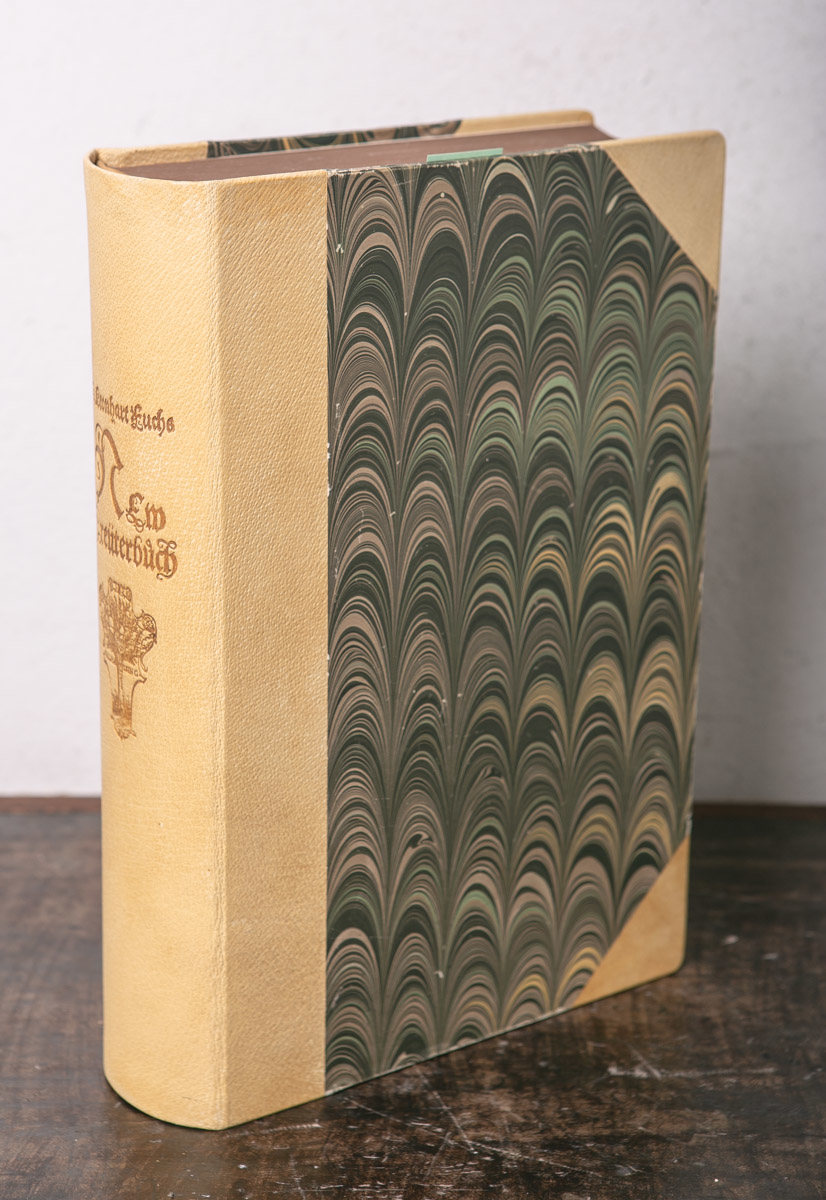FUCHS, Leonhard. New Kreüterbuch. Basel: Michael Isingrin, 1543. 2 o (365 x 234 mm). Woodcut printer's device on title, larger Isingrin device on final recto, full-page woodcut portrait of Fuchs on title verso, 517 botanical woodcuts by Viet Rudolph Speckle after Heinrich Füllmaurer and Albert Meyer, woodcut portraits of the three artists at end, woodcut historiated initials in several sizes (Some worming heavier at end, tear on z6 crossing text/image, blank corner of f3 torn away). Contemporary German blindtooled pigskin over bevelled wooden boards, 2 brass clasps (light staining and wear to corners). Provenance : early ink notations to endpapers; Massachusetts Horticultural Society, Gift of Albert C. Burrage (bookplate). FIRST EDITION IN GERMAN OF PERHAPS THE MOST CELEBRATED AND MOST BEAUTIFUL HERBAL EVER PUBLISHED, (PMM) with amendments and an additional 5 woodcuts. Fuchs, along with Otto Brunfels and Hieronymus Bock, was one of the three German fathers of modern botany. While his main objective in writing the De Historia Stirpium Commentarii Insignes remained in the tradition of Dioscorides and subsequent herbals, describing plants for their medicinal use, Fuchs also gives accurate botanical descriptions of more than 500 plants. The detailed plant-portraits of the first edition were highly influential. They were reused in this and later editions of Fuchs's herbal, successfully compressed in the smaller-format editions of Fuchs, copied in the works of Bock, Dodoens, William Turner and others, and pirated in contemporary botanical works, a use which Fuchs actively contested. They were drawn from life, largely based on plants in Fuchs's garden at Tübingen, by Albert Meyer, transferred to the woodblock by Heinrich Füllmaurer and cut into wood by Viet Rudolph Speckle; portraits of the three artists are included in the work, which is one of the earliest such honors accorded contributing artists. The illustrations depict over 400 German plants and 100 foreign plants, including the first description of several recently-discovered American plants, such as maize (mistakenly thought by Fuchs to originate in Turkey), pumpkin, chili pepper, and snap bean. Aware that Fuchs' original Latin text would appeal primarily to a relatively narrow band of Latinate scholars, Isingrin had it translated into German in order to widen considerably its market. He also appended an additional index of illnesses which could be treated with herbs, thereby further ensuring its popular appeal. Adams F-1107; Cleveland Collections 62; Nissen BBI 659; see PMM 69 (first edition); Pritzel 3139; Stafleu & Cowan TL2 1910.
FUCHS, Leonhard. New Kreüterbuch. Basel: Michael Isingrin, 1543. 2 o (365 x 234 mm). Woodcut printer's device on title, larger Isingrin device on final recto, full-page woodcut portrait of Fuchs on title verso, 517 botanical woodcuts by Viet Rudolph Speckle after Heinrich Füllmaurer and Albert Meyer, woodcut portraits of the three artists at end, woodcut historiated initials in several sizes (Some worming heavier at end, tear on z6 crossing text/image, blank corner of f3 torn away). Contemporary German blindtooled pigskin over bevelled wooden boards, 2 brass clasps (light staining and wear to corners). Provenance : early ink notations to endpapers; Massachusetts Horticultural Society, Gift of Albert C. Burrage (bookplate). FIRST EDITION IN GERMAN OF PERHAPS THE MOST CELEBRATED AND MOST BEAUTIFUL HERBAL EVER PUBLISHED, (PMM) with amendments and an additional 5 woodcuts. Fuchs, along with Otto Brunfels and Hieronymus Bock, was one of the three German fathers of modern botany. While his main objective in writing the De Historia Stirpium Commentarii Insignes remained in the tradition of Dioscorides and subsequent herbals, describing plants for their medicinal use, Fuchs also gives accurate botanical descriptions of more than 500 plants. The detailed plant-portraits of the first edition were highly influential. They were reused in this and later editions of Fuchs's herbal, successfully compressed in the smaller-format editions of Fuchs, copied in the works of Bock, Dodoens, William Turner and others, and pirated in contemporary botanical works, a use which Fuchs actively contested. They were drawn from life, largely based on plants in Fuchs's garden at Tübingen, by Albert Meyer, transferred to the woodblock by Heinrich Füllmaurer and cut into wood by Viet Rudolph Speckle; portraits of the three artists are included in the work, which is one of the earliest such honors accorded contributing artists. The illustrations depict over 400 German plants and 100 foreign plants, including the first description of several recently-discovered American plants, such as maize (mistakenly thought by Fuchs to originate in Turkey), pumpkin, chili pepper, and snap bean. Aware that Fuchs' original Latin text would appeal primarily to a relatively narrow band of Latinate scholars, Isingrin had it translated into German in order to widen considerably its market. He also appended an additional index of illnesses which could be treated with herbs, thereby further ensuring its popular appeal. Adams F-1107; Cleveland Collections 62; Nissen BBI 659; see PMM 69 (first edition); Pritzel 3139; Stafleu & Cowan TL2 1910.






.jpg)





Try LotSearch and its premium features for 7 days - without any costs!
Be notified automatically about new items in upcoming auctions.
Create an alert